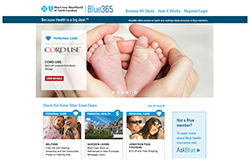*Le estamos enviando a HealthSherpa para comprar su plan de seguro médico de Blue Cross and Blue Shield of North Carolina (Blue Cross NC). HealthSherpa es un vendedor certificado por los Centros de Servicios de Medicare y Medicaid (CMS, en inglés) que Blue Cross NC ha seleccionado para facilitar el proceso de inscripción. Tenga en cuenta que estará saliendo de BlueCrossNC.com y el sitio web de Blue Cross NC. HealthSherpa se hace responsable por el sitio al cual le estamos enviando, incluidas las políticas de privacidad que gobiernan el sitio.
or
How to Shop for a Health Plan
When you’re shopping for a health plan, here are some things to think about:
Subsidies
To help make health insurance more affordable, the federal government offers financial help, also called subsidies, to individuals and families who qualify based on their income and household size. There are two types of subsidies available: Advanced Premium Tax Credit (APTC) and Cost Sharing Reductions (CSRs).
To qualify for a subsidy under health care reform, you must:
- Have income above 100% Federal Poverty Level (FPL)
- Not be eligible for public coverage, such as Medicaid, the Children’s Health Insurance Program (CHIP), Medicare or coverage through the Armed Services
- Not have affordable access to insurance through an employer (“affordable” is defined yearly by the federal Marketplace based on the percentage of premium an employee is responsible for)

Use this online calculator to estimate the subsidy amount you could potentially qualify for from the federal government.
![]()
ACA 101: Subsidies and Cost Sharing Reductions
Network
Each Blue Cross NC health plan has its own network of covered health care providers. The larger the network, the more in-network options you have for doctors, hospitals and other facilities. But plans with a larger network typically have a higher monthly premium. Plans with a health system-specific network are often less expensive and help you get coordinated care, but usually only the doctors and facilities of one major health system are in-network.
So, it’s important to weigh access versus cost when choosing your plan. While some plans offer out-of-network coverage, you can save the most money by only seeing providers that are in your plan’s network.
In the next section, you’ll see the health plans available in your county. Use the Find an In-Network Doctor button to look up providers and hospitals that are covered by that plan’s network.
Health Plan Options
We have lower-cost plans for 2023. Enter your county to see which health plans are available in your area:
Prescription Coverage
Our Affordable Care Act (ACA) plans use the same formulary (a list of covered medications) and pharmacy network.
Use the Find a Drug button to see which medicines are covered and which tier they fall into. Tier 1* is often the least expensive, while Tiers 5 and 6 cost the most.
*Tier 1 drugs on ACA copay plans are not subject to Rx deductible.
Use the Find a Pharmacy button to search for in-network pharmacies.
ACA 101: Plans and Benefits
Copayments, Deductibles and Coinsurance
When shopping for your health plan, you’ll choose between two types: Copayment plans and deductible/coinsurance plans. The type you select affects how you’ll pay for care at the doctor, pharmacy or hospital.
Copayments
A copayment is a fixed dollar amount you pay for a covered service at the time you receive it.
For example, you may have a plan that charges a $20 copay for an in-network doctor visit. All you’ll need to pay is your $20 copay. Plans with copays tend to be more expensive. But, you’ll know the cost of the visit before you go.
Deductibles
A deductible is the amount you owe for covered health care before your health insurance company starts to pay.
For example, let’s say you have a $3,000 deductible and you’ve paid $2,000 toward it. You just had an MRI that costs $1,500. You’ll have to pay $1,000 to reach your deductible. After that, you’ll only pay part of the remaining $500 based on your coinsurance percentage.
If your plan has an integrated deductible that means your medical costs and pharmacy costs both apply toward the same deductible and out-of-pocket maximum.
Coinsurance
Coinsurance is your share of costs for health care expenses based on a percentage of those costs.
After you’ve met your deductible, you may be charged coinsurance for health care services. The cost of the service will be split between you and your insurance company.
So, if you get a $100 bill for a chest X-ray and you have a 30% coinsurance amount, you’ll need to pay $30, and your insurance company will pay the rest.
ACA 101: Copayments, Deductibles and Coinsurance
Health and Well-Being
As a Blue Cross NC member, you’ll enjoy benefits and programs that can help you improve your health and feel your best.
Blue Rewards

Earn gift card rewards for smart health choices, such as learning about your health plan, getting preventative care and more.4
Telehealth

24/7 telehealth care options for behavioral and physical health (available in English and Spanish).5
Blue365®

Grab discounts on products tied to fitness, personal care, healthy eating, wellness, financial health, lifestyle and more.6
Support

Get access to programs to help you control type 2 diabetes and quit smoking.7
ACA 101: Vision and Dental
Catastrophic Health Plans
Are you under 30 or qualify for a hardship through the federal government? You may be eligible for catastrophic coverage.7 These plans have a high deductible, but your monthly payments will be lower than most other plans.
Benefits include:
- 100% preventive care coverage1
- $35 copays for first three non-preventive primary care provider visits
- Essential health benefits covered after deductible is met
- Plans meet ACA Bronze-level requirements



 Blue Connect
Blue Connect